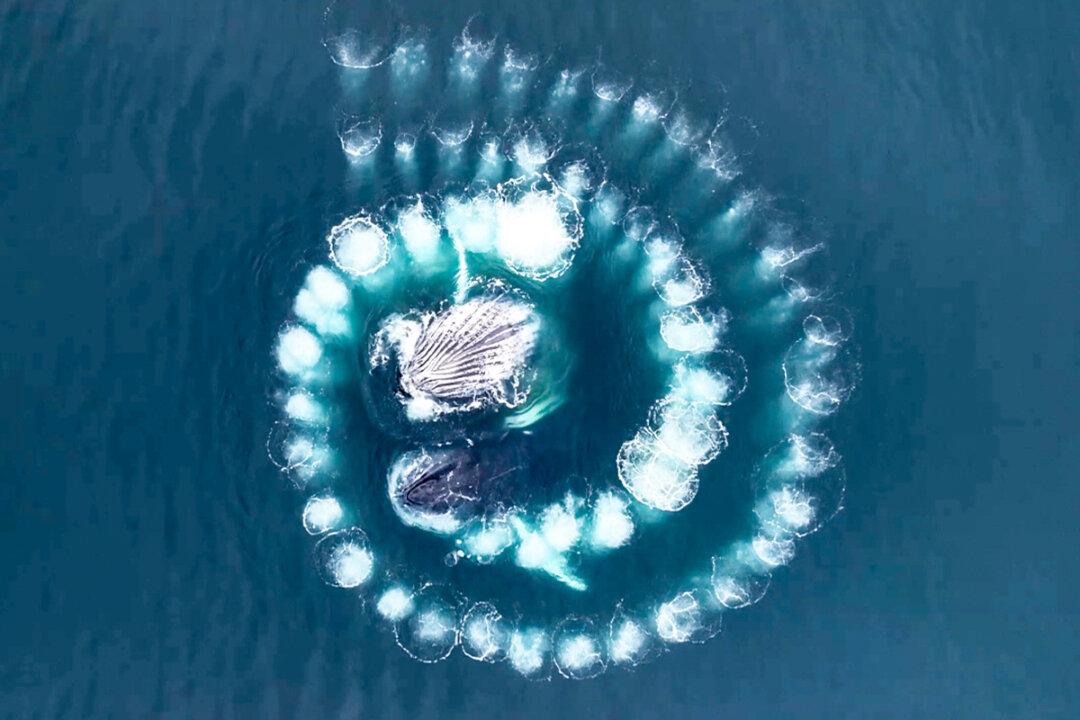A pair of humpback whales has been filmed from above creating a perfect spiral of bubbles under water, and the reason is compelling.
Piet van den Bemd, 28, a wildlife photographer from the Netherlands, was flying his drone over Wilhelmina Bay on the west coast of Graham Land on the Antarctic Peninsula when he caught two humpback whales on film. The whales were engaged in a phenomenon called bubble-net feeding and were working together to corral a school of fish to feed on.
“[T]he bay was filled with big blows from humpbacks,” Mr. Van den Bemd told The Epoch Times. “After a while observing their swimming patterns, it was clear that many of them were feeding.
“Bubble-net feeding by itself an incredible thing to witness, let alone being able to film it. ... In this case, the two whales were executing their dives and bubbles so perfectly, creating that beautiful spiral shape, I knew this was something good. At that moment all I could think was, ‘Keep it steady, hold that camera, and let it happen!’”



Bubble-net feeding, he explained, is an example of cooperative hunting among humpback whales that helps them efficiently catch prey in a concentrated area and showcases their intelligence and social behavior. It is characterized by five stages: coordination, surrounding the prey, confusing the prey, strategic timing, and filter feeding.
Once the prey has been encircled by the bubble net, the whales swim upward through the center with their mouths wide open, taking large gulps of prey-filled water. After closing their mouths, they push the water out through their baleen plates, retaining the prey while the water escapes, then swallow their catch.


“I’ve definitely seen this kind of behavior before, but this time was just unique ... the execution was just perfect, and that beautiful spiral shape reminded many of the golden ratio [and] Fibonacci sequence, beautiful shapes provided by nature,” Mr. Van den Bemd said. “I did absolutely not expect this to go viral at all. It was very overwhelming.”
The beauty of drones is that you can observe without causing a disturbance, said Mr. Van den Bemd, who has an academic background in ecology and wildlife management and travels over 280 days a year, mostly working on expedition ships in the polar regions.
“Every summer, a huge amount of large whales visit the rich Antarctic waters. There’s a lot of food available, that’s why many of these whales make the long migration,” he said. “Obviously, it’s not easy to fly a drone, keeping it all steady and clean, but also to plan the shot, anticipate where it might happen; at the end, it all comes [down] to a lot of luck as well, and I definitely got a lot of it that day!”



Mr. Van den Bemd’s father is a professional photographer, so he grew up surrounded by camera equipment and opportunities for expeditions. “He is the one who teaches me how to look. I think many people these days forget how to look, really,” he said.
He got his first real camera at 16 and started to use it to identify orcas in the north Norwegian fjords. Since going viral with his exquisite footage of humpback whales bubble-net feeding in the Antarctic, Mr. Van den Bemd has had huge support from family, friends, and followers, and has gained media attention that has “opened many new doors” in his professional career.
Watch the video:
“Antarctica is a wild place,” he said. “It’s pristine, it’s the last true wild frontier, and I hope with the photos that I take during my growing career I can convince people to take care of what we have, to respect and to behave, to learn and to protect.”







